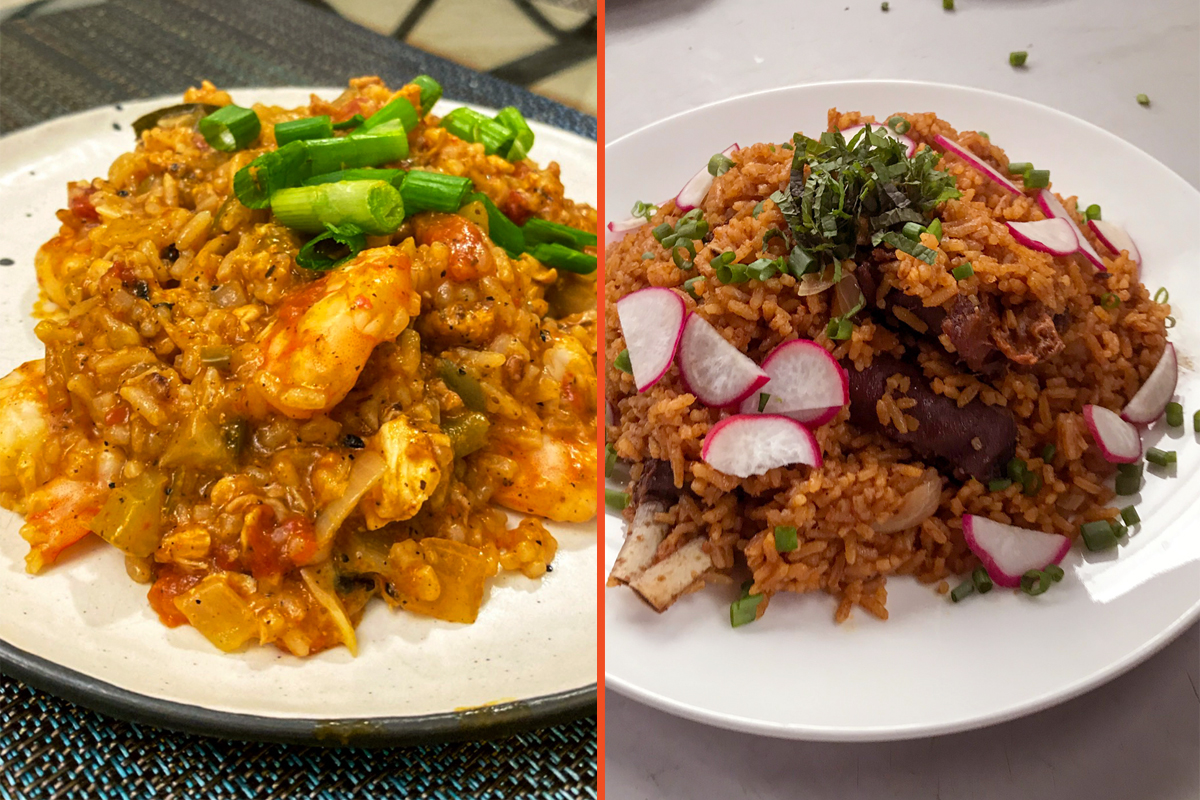Civil Eats partnered with America’s Test Kitchen to develop this story, which today airs an audio version as part of their podcast, Proof from America’s Test Kitchen. Proof goes beyond recipes and cooking to solve food mysteries big and small. Listen here.
My first memories of jambalaya rice date back to my childhood. This signature Louisiana dish made appearances at my childhood home at holidays, large family events, and, occasionally, on the after-church Sunday dinner table. The juicy jumbo shrimp, peppered, earthy andouille sausage, and long grain rice, all blended with tomato paste in one pot, made a distinct, and incomparable meal; until I tried jollof rice on my first trip abroad to Ghana.
It was 2013, and I was in a quiet, unassuming restaurant in Accra. One spoonful of jollof immediately transported me back to the kitchens and restaurants of my youth. The seasoning, although different, were much like the ones my mother and aunts always use in jambalaya. The meat—goat, in this case—paralleled the seafood and andouille sausage; an example of Black people using regional ingredients to make a culinary masterpiece. What really stood out, however, was the combination of rice and tomato paste, which gave the dish a rich, red color very much like the streets of Ghana’s capital. By the end of the meal, I knew that these dishes had to be connected.
[pico_box]
Six years later, Ghanaian President Akufo-Addo declared 2019 “The Year of Return”—a call for the descendants of those forced to migrate to the Americas (beginning in 1619) to endure several hundred years of racialized slavery to return to their homeland. So, this summer, I had the opportunity to mark the birth-right journey by returning to Ghana, both as a Black American and as a reporter.
My motivating question was, I thought, straightforward: Where does jambalaya rice come from, and can jollof rice tell us anything about its origin story?
Jambalaya and Jollof: Different Yet Similar
My question wasn’t new. Academics and historians have long observed the obvious connections between the two rice dishes; not only are the ingredients similar, they’re both also cooked in a single pot. Ghanaians are eager to talk about how jambalaya, along with just about every other dish representative of African American culture, came from West Africa. And in many ways, they’re right. African American food culture—not to mention dance, art, and several of cultural rituals—embody many of the traditions and techniques used throughout West Africa. And yet, there are clear differences, many of which are reflected in jambalaya and jollof.
Jambalaya was first spotted in an 1849 magazine call The American Agriculturalist, just 14 years before Abraham Lincoln signed the Emancipation Proclamation. In the article, Solon Robinson, a white man, wrote about his jambalaya encounter during a trip to Alabama. There were no tomatoes in his recipe, and he also incorrectly refers to it as Hoppin’ John, which typically includes black-eyed peas.
After Emancipation in 1863, African Americans began to write cookbooks that reached the mainstream public. In 1881, What Mrs. Fisher Knows About Old Southern Cooking included a recipe called “Jumberlie” that looked a lot like modern-day jambalaya. As the dish evolved over time, it was commonly identified by the use of tomatoes or tomato paste, as well as a mix of shrimp, andouille sausage, and chicken, Cajun seasoning, and as well as onion, bell pepper, and celery. The dish varies throughout Louisiana and the South, with some versions using fewer tomatoes than others, or sometimes none at all.
My mother, Evelyn Stewart—a school teacher from Baton Rouge and my personal jambalaya expert—believes that the dish was as much a product of our ancestors’ immediate environment as it was a product of the African Diaspora.

Kayla Stewart and her mom, Evelyn, in Houston.
“I was told that our grandparents and great-grandparents created some form of jambalaya because they lived on the waters of Saint Francisville, and they could grow things very well in that part of Louisiana,” she said as we prepped vegetables, deveined shrimp, and sliced andouille sausage while cooking jambalaya together. “The people who came before us didn’t waste and knew how to use their resources.” My mom had nine siblings, so the same rule applied in her childhood home.
As to the broader connections between West African food and South, my mom said, “I’m sure that my ancestors, your ancestors, probably figured, ‘Hey, we can do some of the same things we did back home. We may need to alter it a little bit here and there.’ But I believe they’re the same foods that were brought over.”
Jollof rice, similar to jambalaya, is a one-pot dish that varies drastically across West African nations, leading to one of the most all-in-good-fun national competitions in the world (see #Jollofwars).
It is said to be traceable to 19th-century Senegal. Thiéboudienne—a French transliteration of ceebu jën, from the Wolof words for rice (ceeb) and fish (jën)—is a dish that merges rice, fish, cassava, and carrot. It was the likely invention of a Senegalese cook named Penda Mbaye and is believed by some to be the predecessor to today’s jollof rice. Mbaye was a house cook in the coastal city of Saint-Louis, Senegal, working in the home of the French colonial governor. She created the dish by combining fresh fish with rice, which she used because of a barley shortage, and she also mashed cherry tomatoes into the dish. Other cooks around town heard of her recipe and began cooking rice with tomatoes and fish in all the big houses of Saint-Louis. The dish, which was called “Thiéboudienne Penda Mbaye” after the slave trade had ended, is today the national dish of Senegal.










